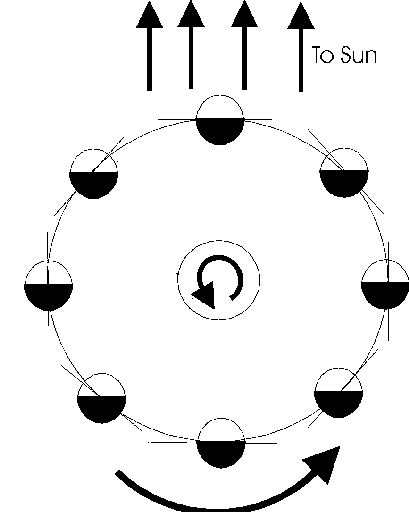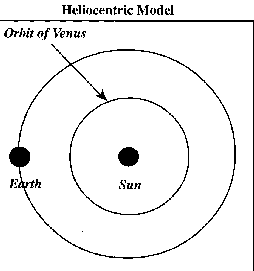Seasons (25 points)
- Do the Pongians in the northern hemisphere experience seasons? Why or why not?
- Is the seasonal (or otherwise) experience of those in the northern and southern hemispheres of Pong the same (at the same time)? Why or why not?
- Does the compass position of the rising (or setting) of their blue sun vary throughout the Pongian year? Explain why or why not.
- Does the Pongian period of daylight change during the year? Why or why not?
- Is the Pongian climate the same at its poles as its equator? Why or why not?
Phases of the Moon (20 points)
To do this question, it might help you to first:
- Locate an Earth-bound observer at sunset on the following diagram.

Briefly explain your answers for parts (a) and (b)
Eclipses (15 points)
- What phase will the moon be in during each eclipse?
- Will the partial solar eclipse be visible to all observers on the day side of the earth at the time of the solar eclipse? Why or why not?
- Will the lunar eclipse be visible to all observers on the night side of the earth at the time of the lunar eclipse? Why or why not?
- Extra Credit: Will the moon be visible during the lunar eclipse? Why or why not?
Choosing Between Models (20 points)
As we saw in class, the retrograde motion of the planets (such as Mars) can be equally well explained by two competing models for the Solar System: the Ptolemaic (Earth stationary at the center) model, and the Copernican (Sun-centered) model. Here we explore an observation that forces us to choose the Sun-centered model over the Earth-centered one!
- (5 points)
Shade the portion of Venus not illuminated by the Sun (here
or on a copy). Remember that the Sun is very far away! Can a "full"
Venus ever be seen from the Earth in this model? Why?
Galileo Galilei was the first person to use a telescope to observe Venus. Over time, he noted that Venus exhibited phases, as shown below:

Galileo knew of the Sun-centered, or heliocentric model developed by Nicolaus Copernicus. Galileo found that this model was able to completely explain the observed phases of Venus.
- Using the diagram below (or a copy), place Venus in the positions
needed to produce the phases seen in panels a and e. Label these positions
with a and e.

- Briefly explain how the heliocentric model accounts for the observed phases of Venus.
- Briefly explain how the sizes of the images of Venus in panels a and e are explained by this model.
Orbits and Gravity (20 points)
- You are on the planet Pong, which is the same size as the Earth, but has 2 times the mass.
- You are on the planet Quing, which has the same mass as the Earth, but is only half as large.
- Extra Credit: What is your mass in parts a-b (compared to your current mass)?
- Is a Quingan year longer or shorter than an Earth year (ie Does Quing have a longer or a shorter orbital period than the Earth)? Explain in terms of gravity. (Hint: Does Quing need to go faster or slower than the Earth in order to maintain its orbit? Why?)
- The Quingan people have discovered another planet (called Zampa) which orbits their star at a distance of 4 AU. Is a Zampan year longer or shorter than a Quingan year? Explain in terms of gravity.